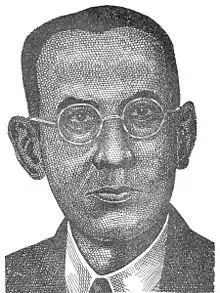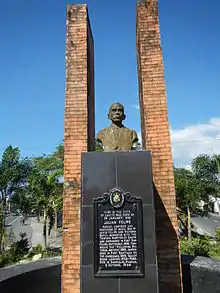Julián Felipe
Julián Felipe (January 28, 1861 – October 2, 1944), was the composer of the music of the Philippine national anthem, formerly known as "Marcha Nacional Filipina", now known as Lupang Hinirang.[1]
Julián Felipe | |
|---|---|
 Julián Felipe, Composer of the Philippine National Anthem | |
| Born | January 28, 1861 |
| Died | October 2, 1944 (aged 83) |
| Occupation | Composer |
| Known for | Composer of the National Anthem of the Philippines |

Early life
Julián Felipe was born in Cavite City. A dedicated music teacher and composer, he was appointed by then-President Emilio Aguinaldo as Director of the National Band of the First Philippine Republic. He died in Commonwealth of the Philippines.
He studied at a public school in Cavite and Binondo, Manila for his primary education. At an early age, he showed his talent in music. He also learned how to play the piano and the organ. Later, he became an organist in St. Peter's Parish Church. As an organist, Felipe was given the chance to hone his gift. Soon after he was composing songs.
Among his early popular compositions were "Moteti el Santesisimo", "Sintos y Floras Rogodones", "Amorita Danza", and "Reina de Cavite", the latter written in honor of Our Lady of Porta Vaga. In recognition of his contributions in the field of music, he was given awards and accolades.
Involvement in the Philippine Revolution
When the revolution broke out, Felipe joined his fellow Cavitenos who fought against the Spaniards. He was arrested and jailed at Fort San Felipe in Cavite.
When freed, he again joined Emilio Aguinaldo's troop. He composed nationalistic songs that inspired his compatriots to continue fighting against the Spaniards. A bust of Felipe can be found in Cavite City, located near San Sebastian College – Recoletos de Cavite.
National Anthem
Aguinaldo asked him to provide a stirring composition to be played in the historic proclamation of Philippine independence. His composition 'Marcha Nacional Filipina', played on June 12, 1898 in Aguinaldo's home in Kawit, was adopted as the Philippine national anthem on September 5, 1938.
In popular culture
- Portrayed by Lou Veloso in the 2012 film, El Presidente.
References
- Lim, Josh. "Philippines "Lupang Hinirang" (Beloved Land)". Retrieved 2007-08-02.
External links
| Wikimedia Commons has media related to Julian Felipe. |
- Historia de la Marcha Nacional Filipino Full text document written by Julián Felipe on the history of the Philippine National Anthem.